You are using an out of date browser. It may not display this or other websites correctly.
You should upgrade or use an alternative browser.
You should upgrade or use an alternative browser.
Phase out date for percussion and cap and ball fireams ?
- Thread starter SIGSHR
- Start date
Driftwood Johnson
New member
Horace Smith & Daniel Wesson filed their patent for a revolver chambered for a self-contained metallic cartridge in 1856. Bored-through cylinders were invented around 1852 by a guy working for Sam Colt, who refused to accept it. The S&W Model 1 was a .22 and was introduced in 1857. The S&W patent expired in 1870 and everybody else jumped.
Howdy
That is not quite correct. The guy who worked for Colt was Rollin White. He came up with the idea to bore chambers all the way through a cylinder to accept metallic cartridges while still in the employ of Colt. He kludged together a prototype from a Cap & Ball revolver, but it was such a monstrosity and so impractical that Colt dismissed the idea. So White patented the idea himself. His patent models were pretty bizarre, and would not have been practical to produce. But the idea of boring the chambers of a revolver all the way through was key to the patent.
Here is White's patent drawing, dated 1855. Part of what was impractical about this design was it employed a spring loaded magazine to load the chambers.
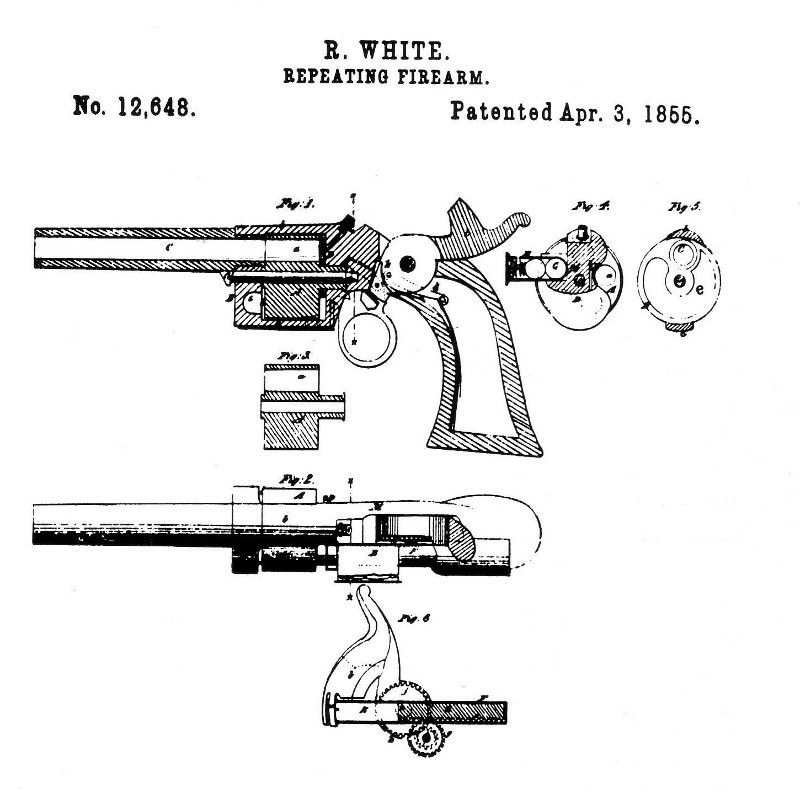
Daniel Wesson independently came up with the idea of boring chambers through a cylinder for his new revolver design. He planned on using a small 22 caliber rimfire cartridge of the type developed by Flobert in France. Wesson did not know about White's patent. When Wesson's patent lawyers did a patent search, they discovered White had already patented the idea of boring the chambers through a cylinder. Smith and Wesson met with White and attempted to buy the rights to his patent, so they could produce cartridge revolvers. White refused to sell the patent outright, so an arrangement was made where S&W would be licensed to produce revolvers using White's idea of boring the chambers through the cylinder. In return S&W paid White a royalty of $.25 for every revolver they made using his patent.
Also part of the contract was that White would not have the right to manufacture firearms using the ideas in his patent, and White would be responsible for chasing down patent infringements. This last part was White's undoing because once other manufacturers realized what a good idea it was to bore a chamber all the way through, there were plenty of infringements to the patent, and White spent most of his money preventing infringement of the patent.
It is interesting to note that contrary to popular belief, S&W never 'owned' the White patent. White continued to own it and licensed S&W to make revolvers using the ideas of his patent. However S&W bought up and controlled a few other patents that later allowed them to make their Top Break revolvers.
The White patent was effectively in force until 1869, when it expired. White attempted to get the patent renewed, but failed. So all through the Civil War, the only American company legally able to manufacture cartridge revolvers was Smith and Wesson. That is why most of the revolvers used on both sides in the Civil War were Cap & Ball revolvers, which were already becoming obsolete.
Here is a photo of the three different sizes of Tip Up revolvers Smith and Wesson was manufacturing at this time. Top to bottom, the 32 Rimfire No. 2 'Old Army', 32 Rimfire No. 1 1/2, and 22 rimfire No. 1.
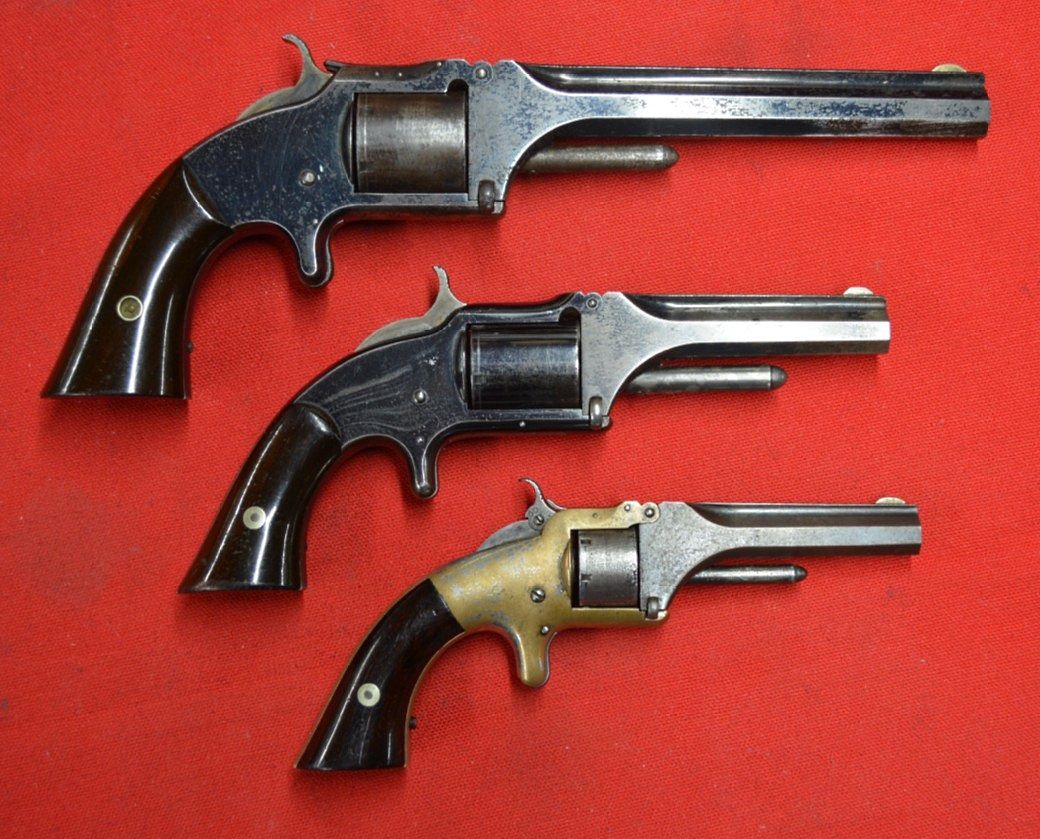
This photo shows how the Tip Ups worked. To load you unlatched a latch at the bottom of the barrel and rotated the barrel up, hence the name Tip Up. You pulled the cylinder out, ejected the empty brass by poking them out with the rod under the barrel, loaded the cylinder with fresh cartridges, put it back in place, and rotated the barrel down to latch it in position. Smith and Wesson experimented with making a 44 caliber Tip Up, but decided the mechanism was not strong enough for a cartridge that large.
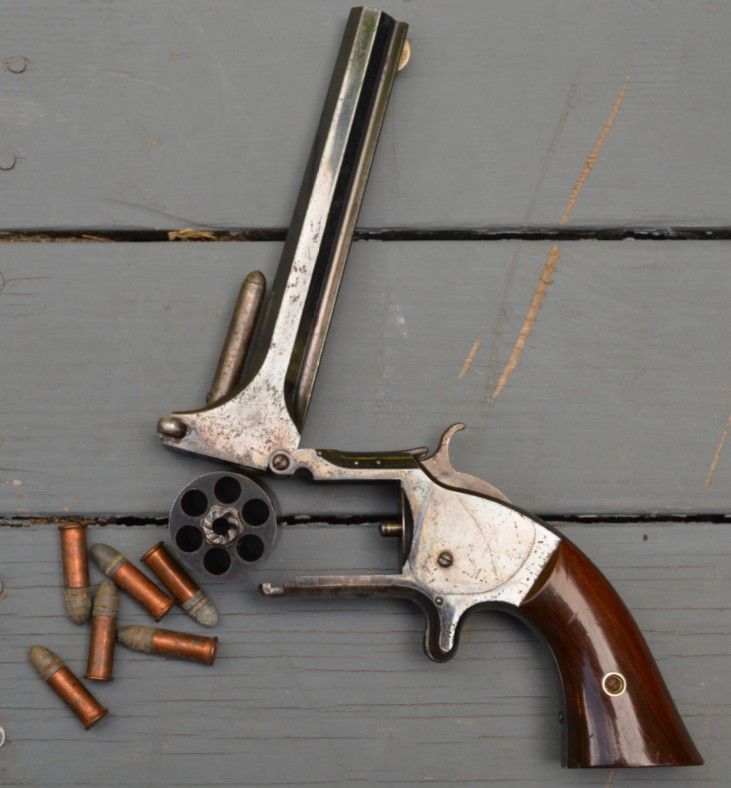
The White patent expired in 1869. Smith and Wesson thought the other revolver manufacturers would be ready with new cartridge revolver designs once the patent expired, so they designed a totally new type of revolver, which they thought would probably be better than whatever the competition unveiled. What they came up with was a large 44 caliber revolver that was loaded by unlatching the barrel and rotating it down.
The first one was the American Model, but I do not own one to show here. Instead, here is the next model, the Russian Model, chambered for the 44 Russian cartridge.
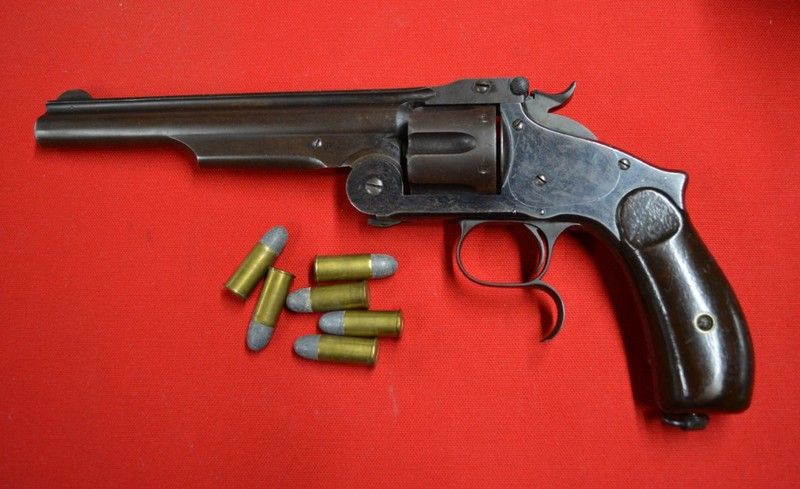
These revolvers featured automatic ejection of the spent brass, which was a new idea. Here is what the Russian looks like as it is broken open and about to eject the spent brass. As the barrel is rotated down, the ejector rises and lifts the spent brass up. When the barrel is rotated all the way down, a spring snaps the ejector back down and the brass should fall clear. In practice, I have learned to give the gun a sidewise flip as I pop out the empties. This helps propel them out. If I don't, the ejector can snap back down and a piece of brass can get caught under it. Which is a pain to clear.
I have rotated the barrel down far enough to raise the ejector almost all the way. If I rotate the barrel a little bit further, a spring will snap it down and the brass should fall clear.
It was very fast to reload these revolvers, much faster than the Colt Single Action Army. Because this style of revolver broke open from the top, they were called Top Breaks.
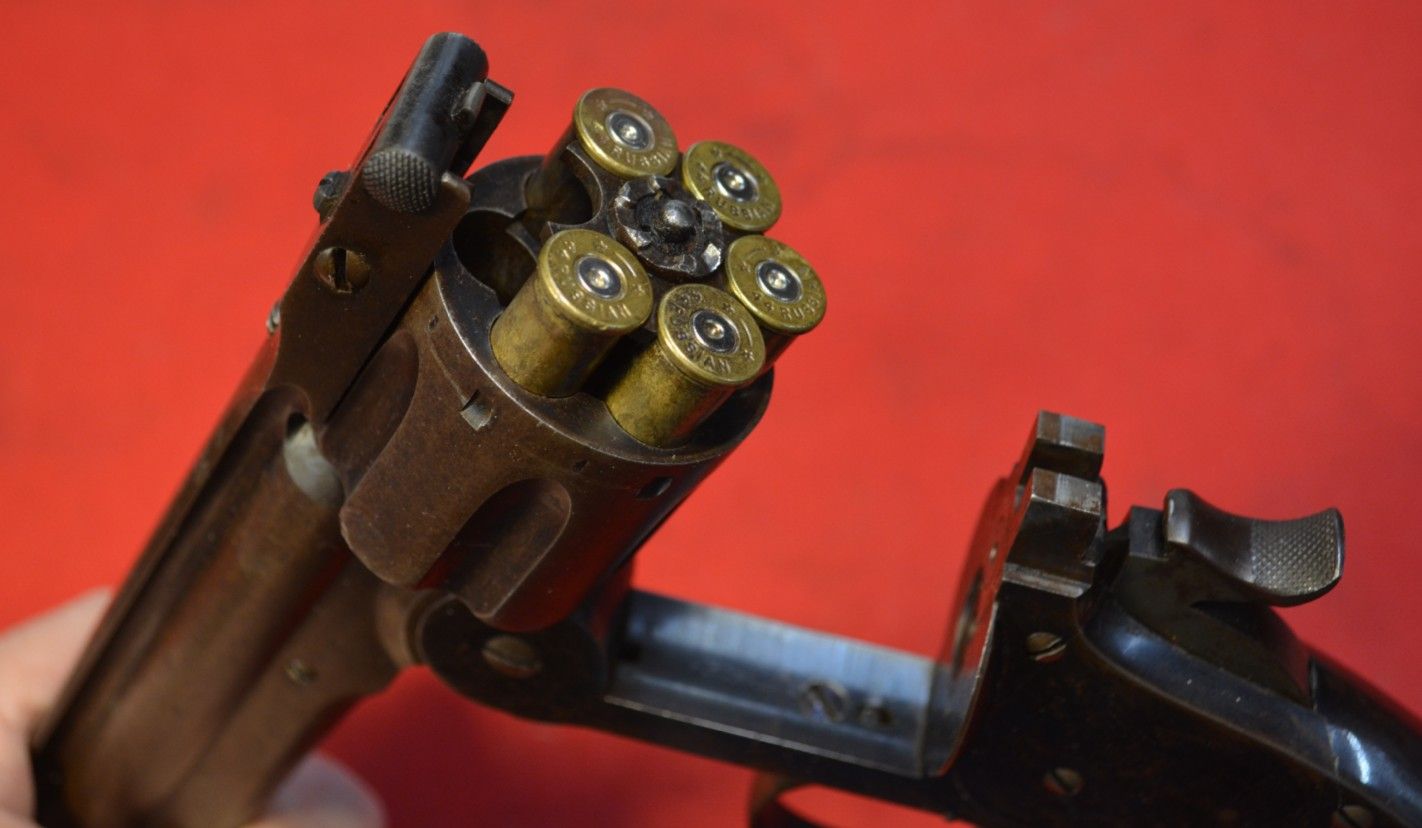
Anyway, 1869 rolled around, and S&W introduced their revolutionary new revolver, and Colt did not have anything ready to compete with it.
Once the White patent had expired, Colt built some 'conversion' revolvers based on their Cap & Ball revolvers, but it was not until 1873 that Colt introduced the Single Action Army, which was a continuation of the Colt percussion revolvers, but had been designed from the ground up to accept cartridges. This is a Colt Richards Conversion, one of several types of 'cartridge conversion' revolvers Colt made before bringing out the Single Action Army. It was modified from the 1860 Army Colt Cap & Ball revolver. The cylinder was machined to accept cartridges, a breech plate was installed in the frame behind the cylinder. The breech plate held a modern style spring loaded firing pin. A loading gate was added on the side, and an ejector mechanism was mounted where the earlier percussion loading lever had been.
The cartridges shown are some original 44 Colt cartridges. The 44 Colt was simply an adaptation to fit into the chambers of a percussion 44 Colt. Groove diameter was actually around .451 (the same as the later 45 Colt cartridge). The 44 Colt bullets were heeled bullets, meaning the rear of the bullet was slightly smaller in diameter than the main part of the bullet. This way, the 'heel' of the bullet fit inside the brass case, and the outside dimension of the bullet and brass case were the same. Just like modern 22 Rimfire ammunition.
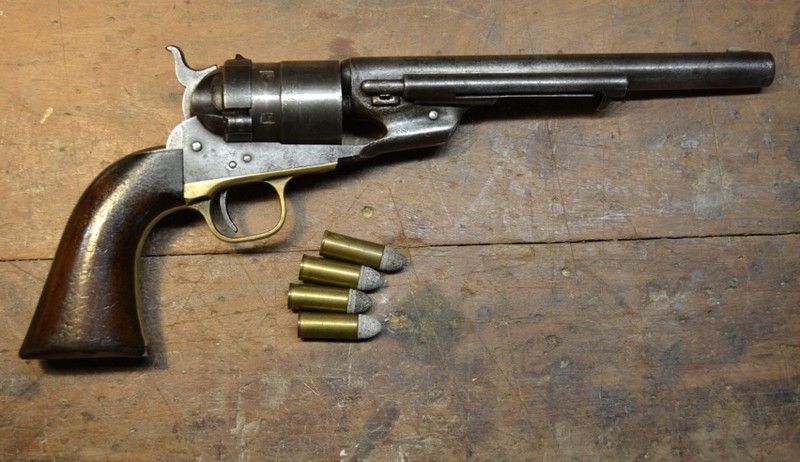
As stated, the Colt Single Action Army first appeared in 1873, and the Army purchased large numbers. At the same time, the government was surplussing out large quantities of percussion Colts and Remingtons left over from the Civil War, so percussion revolvers were available much cheaper than the latest technology, and there were plenty of them.
Remington introduced their version of a cartridge revolver in 1875, but Colt already had a foot hold in the cartridge market, so nowhere near as many Remingtons were produced as Colts.
So all in all, from the earliest days of metallic cartridges in the 1850s, until the 1880s or so, Cap & Ball revolvers gradually gave way to cartridge revolvers.
It did not happen all at once.
There were many other revolver manufacturers too, this has just been the highlights.
Last edited:
bamaranger
New member
wow!!!!!!!!!!!!
Now that, dear readers, is a post!!!!!!!!!!!!!!!!!!!
Now that, dear readers, is a post!!!!!!!!!!!!!!!!!!!
maillemaker
New member
Great post!
Steve
Steve
bladesmith 1
New member
The NMLRA was founded in 1933 and Bill Large was one of the founders. He also was a famous barrel maker, and " chunk gun " shooter. It was matches shot at 60 yards prone resting your gun on a chunk of wood. You'd make a X and hang a sighter next to it. You'd sight in on the sighter, but the gun would hit over a bit by the X. This way you didn't destroy your sight in piece. A friend would stand down near the target and move the sighter so you'd hit dead center on the X. Couldn't you just see today shooting with guys standing next to the targets ? Anyways, it was said when old Bill showed up a lot of guys wouldn't shoot because he always won. He and I use to camp close to each other on the national range. He said he take 10 big steps back and would sometimes win the first couple of places and give the choices of meat to second, third, fourth, and fifth places so they wouldn't complain too much. He made me a 54 cal 48" long barrel a 1 1/8 across the flats for chunk gun shooting. He cherried out a 535 mold to 542 and I had to beat it in with a hammer. That gun would shoot a RB better than I could hold. Being a pistol shooter I sold it after a number of years. Let's see, if he helped start the NMLRA in 33, and he was a famous chunk gun shooter, that means they were doing it still in 33 and up to today. It never did stop in some places. Percussion caps have always been used.
